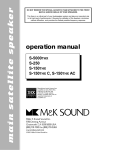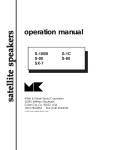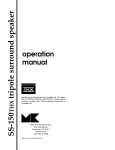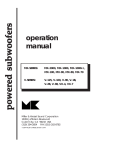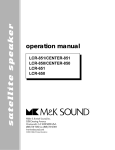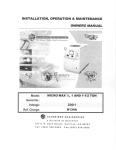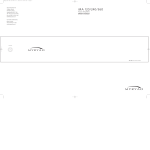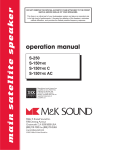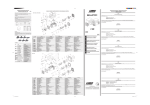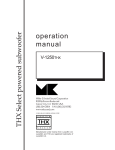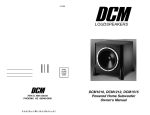Download MK Sound S-150P THX Specifications
Transcript
® THX front channel satellite speakers DO NOT REMOVE THE SPECIAL ACOUSTIC FOAM ATTACHED TO THE FRONT BAFFLE AND/OR GRILLE OF YOUR SPEAKERS. This foam is a critical part of your loudspeaker system and plays an important role in its high level of performance. It focuses the radiation of the tweeters, minimizes cabinet diffraction, and provides the flattest possible frequency response. operation manual S-5000THX S-150THX Miller & Kreisel Sound Corporation 9351 Deering Avenue Chatsworth, CA 91311 USA (818) 701-7010 Fax (818) 701-0369 www.mksound.com ©2001 MILLER & KREISEL SOUND CORP. Manufactured under license from Lucasfilm Ltd. U.S. Patent Numbers 5,043,970; 5,189,703; and 5,222,059. Foreign patents pending. Lucasfilm and THX are registered trademarks of Lucasfilm Ltd. page 2 S-5000THX & S-150THX satellite speakers TABLE OF CONTENTS 1. 2. 3. 4. 5. 6. 7. 8. 9. 10. 11. 12. 13. 14. INTRODUCTION.......................................................................................................3 THE HOME THX AUDIO SPEAKER SYSTEM............................................................3 PLACEMENT OF YOUR M&K THX SPEAKERS.....................................................3 SPEAKER HOOK-UP..........................................................................................4 OPTIMIZING SPEAKER PLACEMENT...........................................................................5 SPEAKER PLACEMENT IN A HOME THX AUDIO SYSTEM..........................................7 USE OF THE "NORMAL" / "SPECIAL INPUT SELECTION SWITCH (S-5000)...............8 USING THE S-5000 WITHOUT GRILLES.......................................................................9 SATELLITE/SUBWOOFER PHASING TEST.................................................................10 SPEAKER DAMAGE & HOW TO AVOID IT...................................................................10 BIAMPLIFICATION WITH AN M&K HIGH-PASS FILTER................................................11 IF YOU NEED SERVICE.................................................................................................11 SPECIFICATIONS..................................................................................................12 CABINET MAINTENANCE............................................................................................12 DIAGRAMS FIGURE 1 WIRING..................................................................................................5 FIGURE 2 SEPARATION BETWEEN LEFT & RIGHT SPEAKERS......................................7 FIGURE 3 S-150 FIGURE 4 USING THE S-5000 WITHOUT GRILLES (FOAM PATTERN)..............................9 & S-150AC SPEAKER ORIENTATION...........................8 DO NOT REMOVE THE SPECIAL ACOUSTIC FOAM ATTACHED TO THE FRONT BAFFLE AND/OR GRILLE OF YOUR SPEAKERS. This foam is a critical part of your loudspeaker system and plays an important role in its high level of performance. It focuses the radiation of the tweeters, minimizes cabinet diffraction, and provides the flattest possible frequency response. S-5000THX & S-150THX satellite speakers page 3 1. INTRODUCTION Congratulations! Your new M&K THX speaker system will give you years of unmatched enjoyment and excitement while listening to your favorite musical and audio/video sources. We encourage you to read this owner’s manual, as there is a great deal of information provided here to help you get the best possible performance. If you have any questions about your speaker system, please contact your M&K dealer or call the M&K factory directly at (818) 701-7010, from 8:30 AM to 5:00 PM Pacific Time, Monday through Friday. We will be happy to help you with any question, no matter how simple or complex it may be. This manual gives you basic hook-up instructions first, followed by more detailed technical, installation, and service information. When handling the S-5000 speaker (not the S-150), do not lift the cabinet by gripping the grilles or the white plastic fittings on the speaker's back baffle. They are not handles! You may damage these parts, affecting the speaker's performance. 2. THE HOME THX AUDIO SPEAKER SYSTEM Your choice of an M&K Home THX Audio speaker system assures you of achieving the state of the art in home theatre music and video reproduction. The precise and exacting standards developed by Lucasfilm's Home THX division, as applied by M&K's engineering team, assure that you will hear every element of film sound - from the softest brush of an object against an actor's clothing to the awesome impact of effects such as an exploding planet - with the same sonic quality heard by the film's director and sound designer as they created the final mix of sound on the studio's dubbing stage. To do this in a home environment requires different equipment and standards than are found in a THX motion picture theatre. The standards developed for Home THX Audio are critically important to achieving the following performance attributes: - wide frequency range, extending to the limits of audibility - smooth, naturally balanced overall sound - excellent dialog intelligibility - wide dynamic range with extremely low distortion - well-matched timbre (tonal balance) between front speakers and surrounds - precise localization of specific sounds (as in special effects) - envelopment by ambient soundfield (without any localization of individual speakers to distract from the action on-screen - superb performance with musical sources The unsurpassed quality of your M&K Home THX Audio speaker system means that all of the excitement and emotional involvement of films and music will be brought to life in your home. Turn down the lights, and let the experience begin! 3. PLACEMENT OF YOUR M&K THX SPEAKERS Your speakers can be installed in a wide variety of locations. They can be placed on stands, shelves, or bookcases, or more permanently mounted using brackets, direct attachment to the wall, or a ceiling suspension system. Your speakers have threaded mounting hardware permanently mounted into the cabinet in different locations on the speaker's back baffle. These allow you to mount the speakers in a wide variety of locations, and to orient them for the best possible sound. This hardware is 1/4 - 20, meaning 1/4 inch in diameter, and 20 threads per inch. page 4 S-5000THX & S-150THX satellite speakers There is a four hole mounting pattern on the rear baffle to accommodate either an Omnimount mounting bracket. The S-5000 uses an Omnimount #100 pattern, and the S-150 uses an Omnimount #75 pattern. This four hole pattern is also used with the M&K speaker stands and wall brackets. You can place your speakers virtually anywhere in the room, but certain locations are better than others. In general, locate them away from obstructions that would interfere with the direct path from the speakers to your ears (such as walls, furniture, lighting, plants, etc.). They will sound better when they are around ear height, or when angled towards your favorite listening location. Unlike most Satellite speakers, the S-5000s are designed to give acceptable performance when they are sitting directly on the floor. Do not hesitate to do this, especially if you have limited space under a projection screen. You will need, however, to tilt them back so the tweeters point up towards your ears. Both the S-150 and S-5000 are magnetically shielded. This means that they can be placed close to a television monitor without distorting the picture. If you place the speaker directly on top of a large screen directview monitor, there is some slight possibility of picture distortion. If that occurs, you may need to move the speaker a few inches or to separate the speaker from the television by a similar distance. Call the factory if you have problems. For more detailed general placement information, see Section 5 on page 5. For detailed Home THX Audio front channel speaker location, see Section 6 (page 7). 4. SPEAKER HOOK-UP The sound quality that you get from your speakers can be affected by the type of speaker wire that you use to connect them. While it is possible to use speaker wire as thin as 22 gauge to hook your S-5000s up, wire of less than 16 gauge will compromise their sound quality. We strongly recommend using the heaviest gauge wire possible. Your special M&K 5-way binding post input terminals will directly accept wire as heavy as 4 gauge! For wire runs of up to 10 feet, 16 gauge wire is acceptable. For runs up to 20 feet, you should use a minimum of 14 gauge. For up to 30 feet, use a minimum of 12 gauge, and over 30 feet should use 10 gauge. See the THX Installation and Operation Manual for more information. There are a very wide variety of premium speaker cables available from a number of specialist manufacturers. We do not endorse any specific brand of premium cable, but we do recommend the highest quality cable that fits your budget. Beware, though — with cables, expensive is not always better. If you have any questions, contact your M&K Home THX dealer for advice. The S-5000 and S-150 are not designed for bi-wiring. We do recommend, however, that they be biamplified with an M&K Powered Subwoofer. If you do not have a THX controller, and you wish to biamplify your speakers in combination with an M&K Powered Subwoofer, see Section 11 (page 10) for more details. WIRING The Positive ( + ) lead from your amplifier or receiver should be connected to the RED ( + ) "INPUT" terminal, and the Negative ( — ) lead from your amplifier or receiver should be connected to the BLACK ( — ) "INPUT" terminal. See Figure 1. page 5 S-5000THX & S-150THX satellite speakers FIGURE 1 WIRING (one channel only is shown for clarity) S-5000THX FRONT SATELLITE SPEAKER Manufactured under license from Lucasfilm Ltd. U. S. Patent numbers 5,043,970; 5,189,703; and 5,222,059. Foreign patents pending. Lucasfilm and THX are registered trademarks of Lucasfilm Ltd. INPUT 4 ohms MADE IN USA MILLER & KREISEL SOUND CORPORATION 10391 Jefferson Blvd., Culver City, CA 90232 310/204-2854 _ LEFT + _ RIGHT + AMPLIFIER 5. OPTIMIZING SPEAKER PLACEMENT The sound quality produced by your speakers can be significantly enhanced by careful attention to their placement. You will get the maximum return in sound quality for your investment in the by following these guidelines as closely as possible. Four factors are important in getting the best sound. They are: A. Height or angle (proper orientation of tweeters relative to listeners' ears). B. Location away from room walls or reflecting surfaces. C. Separation between left and right speakers. D. Vertical orientation of the speaker cabinets. S-5000THX & S-150THX satellite speakers page 6 A. HEIGHT (OR ANGLE) Your M&K speakers will always deliver sound superior to conventional speakers, regardless of where you locate them or where you are when you are listening. However, because of their design, they achieve their very best sound quality and their flattest frequency response when properly oriented relative to your ear. Ideally, your speakers' tweeters should be at the same height from the floor as your ears when you are sitting in your main listening position. Specifically, this means the distance from the floor to the space between the two tweeters (S-5000) or to the center tweeter (S-150). If you have the speakers mounted above or below this height, you must tilt the speakers so that the tweeters are aimed at your ears when you are in the main listening position. If you have the special Angled Center version of the S-150 (S-150AC), its front baffle has a built-in "tilt" that aims the sound either up or down depending on orientation. This speaker is ideal for use as the center channel speaker sitting on top of a rear-projection television set. Start by aligning the speakers visually. Sit in your main listening position and look at the cabinets' tops and bottoms. When their perspective is about the same relative to where you are sitting (about the same angle), you are at least very close to the proper alignment. The best way to determine the proper angle is to have a helper move the speakers while you sit and listen. You should be able to hear the difference when the speakers are in the best location by listening for the brightest high frequencies and for the best "focus" of sound, where you hear the sharpest sonic imaging of voices and instruments. To do this, play Chapters 8 - 10 on the Lucasfilm "Wow" Laserdisc, or any other source of pink or white noise. When the speakers are aimed properly, you will hear the greatest amount of high frequencies. You will be able to hear a distinct difference in the highs when each speaker is at the correct angle. B. LOCATION AWAY FROM REFLECTING SURFACES Your speakers should generally be located away from walls, furniture, or any other reflecting surfaces. Any object located close to the speaker will reflect the sound radiated from the speaker to your ear with a slight time delay compared to the direct sound reaching your ear. This time delay will blur the sonic imaging and interfere with transient performance. The delay is very slight, so instead of hearing an echo, you hear a "blurred" sound with less clarity that is not as sharp and distinct as it should be. This time delay also affects frequency response and sonic imaging. Bear in mind, however, that while many satellite speakers do not perform well when placed on the floor, the S-5000 is designed to deliver good performance whether sitting on the floor or mounted above it. If the speakers will be sitting on shelves, locate them on the front edge of the shelf, so there is no flat surface directly in front of them. If any speaker will sit close to a wall or any other large object, leave as much space as possible between the speaker and the object. Ideally, your speakers will be located away from the nearest surface, but in most rooms compromise will be necessary. C. SEPARATION BETWEEN LEFT AND RIGHT SPEAKERS Here is a formula for achieving the ideal left to right stereo imaging. Think of a triangle formed by the locations of the left and right speakers and your listening position. Ideally, the subtended angle formed should be between 45 and 50 degrees. Roughly, this means that the left and right speakers should be separated by about the same distance that you are sitting back from the speakers. In other words, if the distance from your listening position to the point directly between the speakers is 10 feet, place the speakers so their centers are about 10 feet apart. See Figure 2. The length of line A - B should be about the same as the length of line X - Y. (They may not seem to be the same in this diagram due to an optical illusion). Try to follow the formula as close as you can. You can fine tune the placement by listening to a source with an image (such as a vocalist) centered between the speakers. When listening in stereo (no Center Channel speaker), move the speakers closer together or farther apart in small increments until you hear the sharpest and most cohesive image, especially in the phantom center. You may also want to angle (or "toe-in") the speakers slightly. This often improves the sharpness of the stereo image, and provides a wider seating area. The S-150 Left and Right speakers provide a default toe-in through the angle of their front baffles. page 7 S-5000THX & S-150THX satellite speakers FIGURE 2 SEPARATION BETWEEN LEFT & RIGHT SPEAKERS A X Y LEFT SPEAKER RIGHT SPEAKER Line X - Y should equal line A - B. (Line A - B appears longer in this diagram due to an optical illusion) B D. VERTICAL ORIENTATION The performance of your speakers is dependent on their orientation. THX speakers are designed for controlled vertical dispersion and wide horizontal dispersion. By controlling the vertical dispersion, we limit the amount of sound that would otherwise be reflected with a time delay from the floor and ceiling (for the reasons discussed in B. above). This means the speakers should always be vertically oriented. The S-150 is vertically oriented when its tweeters are vertically stacked (not next to each other). When vertical, the controlled dispersion is in the correct plane. If they are oriented horizontally (on their sides), listeners right or left of a direct line from the center of the speaker will hear a compromised sound quality, an irregular frequency response, as well as some other problems. While this may be acceptable for background listening, we strongly recommend that you do not place them on their sides for any other listening. The S-5000 and S-150 must be oriented vertically (tweeters in a vertical line) to meet THX requirements. 6. SPEAKER PLACEMENT IN A HOME THX AUDIO SYSTEM If your M&K speakers are being used in a Home THX Audio system, placement is very important. You should take at least the same amount of time and care in setting up your M&K Home THX speakers as you would with the most exotic high-end stereo system. Some listeners make the mistake of taking too casual an approach to the installation of speakers in a home theatre system. In fact, in many ways the setup of speakers in a home theatre is more critical than for stereo. Even though the S-5000 and S-150 are less influenced by the room environment than most other speakers, the time you spend in carefully installing them will significantly enhance your enjoyment of them later. The Left, Center and Right speakers should ideally all be at the same height as the television screen. Because the Center channel speaker cannot cover the screen, in will have to be placed above or below the screen. Try to set up all three speakers at the same height. If this is not practical, set them up so that they are no further apart vertically than the speakers' two foot height. In other words, the bottom of the speaker the farthest from the floor should be no higher than the top of the speaker closest to the floor. Remember that the speakers need to be aimed at the listening position when they are not placed with the page 8 S-5000THX & S-150THX satellite speakers tweeters at the same height as the listeners' ears. Your speakers have great flexibility in combination with stands, mounting brackets, or speaker hangers to make this easy to accomplish. Remember that they are designed to be installed vertically, with the tweeters aimed at the listeners' ears. They can, however, be placed at virtually any height. This includes sitting directly on the floor, tilted up, as well as being mounted at ceiling height and tilted down. Just remember that all three speakers should be at the same height or as close to the same height as possible. If desired, a slight toe-in of the Left and Right speakers will improve the sound quality for listeners away from the center position, and can often improve imaging and overall sound quality by reducing the amount of side wall reflections reaching all listeners' ears. The S-150 Left and Right speakers give you a built-in toe-in through their angled front-baffle design. See Figure 3 below for speaker orientation. For additional information regarding speaker placement, see the THX Installation Manual. FIGURE 3 S-150 & S-150AC SPEAKER ORIENTATION S-150 Left (tweeters to outside) S-150 Center (tweeters may be oriented to either left or right) S-150 Right (tweeters to outside) S-150AC Angled Center (aiming down towards listeners) Using S-150AC Angled Center version Television Set 7. USE OF THE "NORMAL"/"SPECIAL" INPUT SELECTION SWITCH (S-5000 ONLY) The "NORMAL"/"SPECIAL" Input Selection Switch, found on the back panel of the S-5000, allows for greater flexibility in the use and installation of the S-5000 speaker. Under most conditions, this switch should be set to the "NORMAL" position. However, there are specific conditions where the performance of the S-5000 is improved when set to the "SPECIAL" position, such as when the speaker is placed directly against a room boundary surface (wall, floor, or ceiling). page 9 S-5000THX & S-150THX satellite speakers A. "NORMAL" SWITCH POSITION When you are using the S-5000 away from walls, the floor, or ceiling, the switch should be set to the "NORMAL" position. This includes placement on stands, risers, in furniture, suspended from ceilings, etc. Unless the speaker is in direct contact with a wall, floor, or ceiling, use the "NORMAL" switch setting. If in doubt, use the "NORMAL" position or contact the M&K factory for more information. B. "SPECIAL" SWITCH POSITION When any loudspeaker is in direct contact with a room boundary surface (wall, floor, or ceiling), its frequency response is modified by that contact. Specifically, that contact increases the bass and midbass output of the speaker. If a speaker (such as the S-5000) is designed for flat frequency response away from room surfaces, placing it against a surface may cause its sound to become "muddy" or "boomy". If you are locating your S-5000s so that they are in contact with a wall, floor, or ceiling, set this switch to the "SPECIAL" position. This will attenuate the bass and midbass output of the speaker to compensate for the increased bass produced by the speaker's room location. Feel free to experiment with the switch in both positions to find the one that gives the flattest response in your room. Use the SPECIAL position if you are optimizing your system's response with a THX or third-octave equalizer and calibrating that equalizer by using a third-octave analyzer. The SPECIAL position will always maximize output and dynamic range, and will play the loudest, regardless of the size of amplifier that you are using. The reason that you may find that the SPECIAL position gives the best response when you are locating the speaker directly against a wall or directly against the floor or ceiling is because this position is designed to account for the increase in midbass response that occurs when a speaker is directly against a room surface. (This is referred to as 2 pi space, in contrast to a speaker located out in a room, which is known as 4 pi space. The SPECIAL position should be used for 2 pi conditions, and the NORMAL position should be used for 4 pi conditions). 8. USING THE S-5000 WITHOUT SPEAKER GRILLES If you look on the front baffle and inside the speaker grilles of your S-5000 speakers, you will find some unusually-shaped pieces of foam. Do not remove this foam. This special acoustical foam is an integral part of the speaker and an important element in its performance. FIGURE 4 USING THE S-5000 WITHOUT GRILLES (FOAM PATTERN) TOP VIEW OF THE FOAM PIECES PICTURED ON THE FRONT VIEW. PLEASE NOTE: THE ANGLED SIDE OF THE FOAM MUST GO TO THE OUTSIDE OF THE CABINET. ATTACH THESE TWO PIECES OF FOAM TO THE SPEAKER'S FRONT BAFFLE WHEN THE SPEAKER WILL BE USED WITHOUT A GRILLE FRONT VIEW TOP VIEW S-5000THX & S-150THX satellite speakers page 10 The foam that is located inside the speaker grille is very important. Therefore, any time the S-5000 is used without its speaker grille, it is very important that that foam be replaced. If your S-5000s are being installed behind other cloth grilles in order to conceal them (or behind a THX front projection screen), the regular speaker grilles should be removed. In these cases, please contact the M&K factory at (310) 204-2854, and we will send, at no charge, replacement self-adhesive foam pieces that can be easily applied to the cabinet's front baffle. This will replace the foam normally held in place by the speaker grille and will insure that you get maximum performance from your S-5000s. If any of the other foam pieces become damaged, please contact us and we will send replacements. 9. SATELLITE/SUBWOOFER PHASING TEST In any system using a subwoofer separate from Satellite speakers, a phasing test must be performed to insure good bass blending. This test insures optimum sound in the critical bass frequencies where your Subwoofer and Satellite speakers overlap. HOME THX AUDIO SYSTEM For a Home THX Audio system, follow the system instructions provided with the THX controller, as you will need to have correct phase among all the speakers in the system. These instructions will take you through the front channels, surround channels, and subwoofer. SATELLITE/SUBWOOFER SYSTEM If you own an M&K THX Powered Subwoofer, see its owner's manual for the correct procedure for matching phase between the Satellites and Subwoofer. Its "SUBWOOFER PHASE" switch makes this important test very easy. If your subwoofer does not have a "SUBWOOFER PHASE" switch, follow this procedure: Play a familiar CD, LP, or tape with steady, consistent bass content through your system. Listen carefully to the "mid-bass" region of 75 - 125 Hz. This is the part of the spectrum where electric or string basses and drums predominate. Then, reverse the Positive and Negative speaker inputs on the back of BOTH Satellite speakers. You can do this at the back of both Satellite speakers, or at the Subwoofer's "TO SPEAKERS" terminals, but never at both locations. The lead that was on the Positive (+) terminal should be switched to the Negative (—) terminal, and vice versa. Now listen to the same musical passage as you did earlier, concentrating on the mid-bass region. If you hear less bass, the original connections were correct. If you hear more bass, the new connections are correct. You need to perform this test because when Satellite speakers are located separate from a Subwoofer, each speaker is at a different distance from your ear. In some cases, the difference will be just enough so that the output from the Subwoofer arrives out of phase with the output of the Satellites. When this happens, that critical mid-bass is actually cancelled. You should re-do this test any time you move your speakers. If you want to experiment further, you can move the Satellite speakers either towards or away from your listening position, making changes in small increments. This will "focus" the system's sound to its optimum. When you hear the best balance between stereo image localization and maximum impact and output in the midbass, you have the ideal location. 10. SPEAKER DAMAGE & HOW TO AVOID IT An important factor to consider with any loudspeaker system is the potential for speaker damage. Even though your speakers have extremely high power handling ability, they still can be damaged by relatively low powered amplifiers. While very few M&K Satellites are actually returned for service, the vast majority of those returned are not for manufacturing defects. Instead, they are returned because they have been overdriven, almost always because the amplifier or receiver used was driven into clipping distortion. This damage is considered abuse, and is not necessarily covered under warranty. This clipping distortion occurs when the demands of the music are greater than the amplifier's available power. It can occur at 20 watts with a small amplifier, or at 400 watts with a large amplifier. Regardless, when this happens, the amplifier's output waveform (which usually looks like a smooth arc) is "clipped" off, exhibiting a flat top instead of the arc. S-5000THX & S-150THX satellite speakers page 11 This flat top contains multiples of the original amplified frequencies, sometimes at higher levels than the original signal itself. For tweeters, this can be very damaging, as this distortion is well above the audible range, where you will be unable to hear it, and where the tweeter is more vulnerable to damage. When an amplifier clips, its sound becomes harsh and grating, and a break-up is often audible in the bass frequencies. It will become uncomfortable to listen to, compared to a slightly lower volume level. When you are listening at high volume levels, be aware of the onset of clipping distortion, and turn the volume down slightly if the sound takes on the character described above. When tone controls or equalizers are used to boost frequencies, the problem occurs much more rapidly. Even a small boost of low or high frequencies can easily double the power requirement and lead to amplifier clipping at moderate levels. Therefore, you should use your tone controls judiciously, avoiding extreme boosts of the bass and treble controls, especially when you are listening at high volume levels. The best way to avoid speaker damage is to use common sense. Use moderate boosts of tone controls or equalizers, at the very most. Listen carefully for any harshness and break-up, especially at high volume levels, and turn down the volume when needed. If you cannot get enough volume, you may need to consider a higherpowered amplifier. If you have any questions about this, please contact M&K, and we will be happy to discuss it with you further. 11. BI - AMPLIFYING YOUR SATELLITES WITH M&K HIGH PASS FILTERS One excellent way to improve the sound of your Satellite speakers (and protect them if you listen at high volume levels to music with substantial deep bass output), is by using an M&K High-Pass Filter. The M&K HP-80 and VF-80 High-Pass Filters improve the performance of any system that allows for separation of its preamp and power amp stages, by filtering the bass signal fed to the main amplifier and Satellite speakers. These filters will give you greater dynamic range, lower distortion, and an increased maximum output level. If you have any questions about the suitability of your components, please contact your M&K dealer or the factory. To use these filters with an integrated amp or receiver, the amp/receiver MUST have back panel RCA jacks labelled Preamp/Main Output AND Power Amp/Main Input (or Front Out/Front In) for all of the channels you want to filter (including the center channel). You may have to operate a switch or remove jumper connections on the amplifier. If you can use one of these filters, you simply connect one set of shielded RCA - RCA interconnect cables between the receiver, amp or preamp's Main Output and the HP-80 or VF-80, with a second set between the HP-80 or VF-80 and the Main Input of the receiver or amplifier, and a third set from the HP-80 or VF-80 to the Subwoofer. See the instruction sheet that comes with the High-Pass Filter for more information. 12. IF YOU NEED SERVICE Contact your dealer or M&K with a complete description of the problem. Please have the unit's model and serial numbers (found on the back of the cabinet), date of purchase, and your dealer's name. You can call M&K between 8:30 AM and 5:00 PM Pacific Time, Monday through Friday, at (818) 701-7010. If you call outside these hours, leave a message, and we will return your call. DO NOT RETURN YOUR SPEAKERS TO THE FACTORY FOR SERVICE WITHOUT OBTAINING PRIOR AUTHORIZATION. All M&K Satellite speakers carry a five year limited parts and labor warranty. This warranty is transferable to new owners up to three years from the date of original purchase, and it includes Subwoofer amplifiers. It does not cover abuse, misuse, repairs by unauthorized service stations, speakers without serial numbers, and those damaged in shipping or by accident. If you have any questions about the warranty, please contact M&K. page 12 S-5000THX & S-150THX satellite speakers 13. SPECIFICATIONS IMPEDANCE: MINIMUM POWER: RECOMMENDED POWER: (applies to both models) MAXIMUM POWER: (applies to both models) FREQUENCY RESPONSE: DIMENSIONS (H x W x D): Angled Center Channel speaker WEIGHT RECOMMENDED STANDS OMNIMOUNT BRACKET S-5000THX 4 ohms 10 watts RMS S-150THX 4 ohms 10 watts RMS amplifiers with between 50 and 400 watts RMS or more (see below) 400 watts RMS unclipped peaks 72 Hz - 20 KHz ± 2 dB 82 Hz - 20 KHz ± 2 dB 24" x 11 5/8" x 12" 12 1/2" x 10 1/2" x 12" N/A 12 1/2" x 10 1/2" x 12 1/4" 55 lbs. 23 lbs. M&K ST-1 Base M&K ST-1 Base Series 100 Series 75 14. CABINET MAINTENANCE The genuine oak veneer or painted black cabinets of your M&K S-5000s have a furniture-grade finish that will maintain its attractive appearance with proper care. Treat the cabinet as you would any piece of fine furniture. If your cabinet is natural oak, rubbing the wood periodically with an oil or polish will enhance its beauty and protect its finish as long as you own it. If your cabinet is painted black oak, regular dusting and cleaning is all that is required. Matching black paint can be used if necessary to repair any surface damage. The S-150's painted black finish does not require any special maintenance; regular dusting with a lint-free cloth and periodic cleaning is all that is required. Matching black paint can be used if necessary to repair any surface damage. s150500.pm5 rev 01.10/01 pn# 70320












